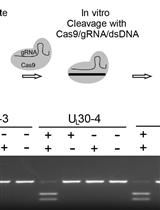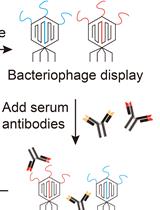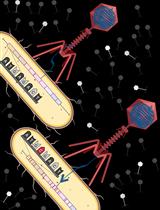- EN - English
- CN - 中文
siRNA Screening for Genes Involved in HSV-1 Replication
对参与HSV-1病毒复制的基因进行siRNA筛选
发布: 2014年08月20日第4卷第16期 DOI: 10.21769/BioProtoc.1209 浏览次数: 11189
评审: Pinchas TsukermanAnonymous reviewer(s)
Abstract
Small interfering RNAs (siRNAs) are small (typically 18-24 nucleotides) RNA molecules capable of silencing gene expression post-transcriptionally and as such, they provide a simple method by which the role of individual genes in complex cellular systems can be easily assessed. As siRNAs are easy to use experimentally, and can be designed to target any gene (including pathogens), their use is perfectly suited to and easily adapted to high-throughput genome-wide screening methodologies and a range of phenotypic assays. Here we describe the use of a large siRNA library (>8,000 genes targeted individually) to screen for and identify host factors functionally involved in the replication of a human herpesvirus (Herpes simplex virus type 1; HSV-1) (Griffiths et al., 2013; Griffiths, 2013).
Materials and Reagents
- Hela cells (ATCC, catalog number: CCL-2 )
- siRNA library (e.g. human siGENOME SMARTpool Druggable Genome siRNA library 0.5 nmol) (Thermo Fisher Scientific, catalog number: G-004605-05 )
- 5x siRNA buffer (Thermo Fisher Scientific, catalog number: B-002000-UB-100 )
- RISC-free (RSCF) control siRNA (20 nmol) (Thermo Fisher Scientific, catalog number: D-001220-01-20 )
- Scrambled, non-targeting control siRNA (20 nmol, human) (Thermo Fisher Scientific, catalog number: D-001206-13-20 )
- Assay-specific control siRNAs
- Fetal bovine serum (FBS) (LabTech, catalog number: FCS-SA-10454 )
- Penicillin:streptomycin (5,000 units/ml each) (Lonza, catalog number: DE17-603E )
- 1x trypsin-EDTA liquid (0.05% Trypsin, 0.53 mM EDTA-4Na) (Life Technologies, catalog number: 25300096 )
- Phosphate buffered saline without magnesium or calcium (Lonza, catalog number: 17-516F )
- DMEM 4.5 g glucose/litre with L-glutamine and sodium pyruvate (Lonza, catalog number: BE12-604F )
- 1x DMEM/F12 1:1 (15 mM HEPES + L-glutamine, no phenol red) (Life Technologies, catalog number: 11039021 )
- Hank’s balanced salt solution (HBSS) (Thermo Fisher Scientific, catalog number: HYC-001-181W )
- Dharmafect 1 siRNA transfection reagent (Thermo Fisher Scientific, catalog number: T-2001 )
- Sterile DNase and RNase-free distilled water (Life Technologies, catalog number: 10977-049 )
- Ethanol (diluted in sterile RNase and DNase-free water)
- CellTiter-Blue® cell viability reagent (Promega Corporation, catalog number: G8081 )
- HSV-1-eGFP reporter virus (Arthur et al., 2001)
- Growth medium (see Recipes)
- Transfection medium (see Recipes)
Equipment
- Pipette tips for robotic liquid handler (Axygen Zymark 200 µl sterile tips) (VWR International, catalog number: AXYGZT-200-L-R-S )
- Polystyrene plate covers for 96-well plates (Thermo Fisher Scientific, catalog number: AB0752 )
- Aluminium heat-sealing film for storage microplates (Thermo Fisher Scientific, catalog number: AB-0559 )
- Adhesive plate seals (Starlab, catalog number: E2796-9793 )
- 384-well storage plates (Thermo Fisher Scientific, catalog number: AB-0781 )
- Black 384-well clear flat-bottomed, sterile, tissue culture-treated plates (VWR International, catalog number: 734-1640 )
- 75 cm2 filter cap tissue culture flasks (Sigma-Aldrich, catalog number: C7106 )
- 175 cm2 filter cap tissue culture flasks (Sigma-Aldrich, catalog number: C7481 )
- 50 ml centrifuge tube (Corning, product number: 430290 )
- Disposable hemocytometer (KOVA Glasstic slide 10 with counting grid) (HYCOR Biomedical, catalog number: 87144E )
- Class II Microbiological safety cabinet
- Humidified cell culture incubator (37 °C, 5% CO2)
- Pipette aid (Alpha laboratories, catalog number: 4-131-201-E )
- Centrifuge (e.g. Eppendorf, catalog number: 5811-000.010 )
- Light microscope
- 8-channel multichannel pipette (2-10 μl volume) (Thermo Fisher Scientific, catalog number: 4661000 )
- Multidrop 384 reagent dispenser (Thermo Fisher Scientific, catalog number: 5840150 )
- Multidrop 384 standard tube dispensing cassette (Thermo Fisher Scientific, catalog number: 24072670 )
- RapidPlate 384 robotic liquid handler (or equivalent) (discontinued) (QIAGEN)
- Microplate heat sealer (e.g. ALPS 50 V Microplate heat sealer) (Thermo Fisher Scientific, catalog number: AB-1443 )
- Gas-permeable adhesive microplate seals (Thermo Fisher Scientific, catalog number: AB-0718 )
- Barcode printer (e.g. Brady® LABXPERT™ printer) (Sigma-Aldrich, catalog number: Z664588 )
- Brady® LABXPERT™ printer labels (Thermo Fisher Scientific, catalog number: 12879858 )
- Fluorescent plate reader (e.g. POLARstar OPTIMA, BMG LABTECH)
- Stacker for plate reader (BMG LABTECH)
Software
- Microsoft Excel
Procedure
文章信息
版权信息
© 2014 The Authors; exclusive licensee Bio-protocol LLC.
如何引用
Readers should cite both the Bio-protocol article and the original research article where this protocol was used:
- Griffiths, S. J. and Haas, J. (2014). siRNA Screening for Genes Involved in HSV-1 Replication. Bio-protocol 4(16): e1209. DOI: 10.21769/BioProtoc.1209.
- Griffiths, S. J., Koegl, M., Boutell, C., Zenner, H. L., Crump, C. M., Pica, F., Gonzalez, O., Friedel, C. C., Barry, G., Martin, K., Craigon, M. H., Chen, R., Kaza, L. N., Fossum, E., Fazakerley, J. K., Efstathiou, S., Volpi, A., Zimmer, R., Ghazal, P. and Haas, J. (2013). A systematic analysis of host factors reveals a Med23-interferon-lambda regulatory axis against herpes simplex virus type 1 replication. PLoS Pathog 9(8): e1003514.
分类
系统生物学 > 基因组学 > 测序
分子生物学 > RNA > RNA 干扰
分子生物学 > DNA > 诱/突变
您对这篇实验方法有问题吗?
在此处发布您的问题,我们将邀请本文作者来回答。同时,我们会将您的问题发布到Bio-protocol Exchange,以便寻求社区成员的帮助。
Share
Bluesky
X
Copy link














